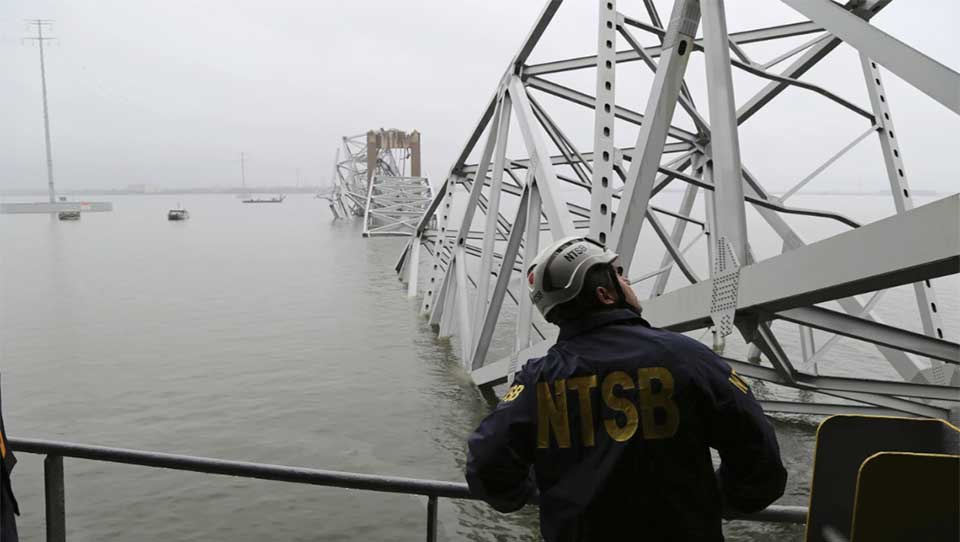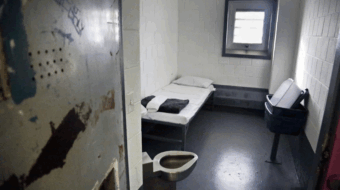
BALTIMORE—Destruction of the vital Francis Scott Key Bridge in Baltimore, when a city-block-long container cargo ship weighing almost 100,000 tons lost power and crashed into a central pier on March 26, will have wide ramifications for jobs, trade, and infrastructure.
Five workers filling potholes on the bridge as part of a night crew, and their supervisor, died when the Singapore-registered freighter Dali hit a bridge pier at 1:30 am, sending it crashing in ruins into the Patapsco River. Two workers survived. Like a large share of construction workers nationally, all eight who plunged into the river migrated from Central America and lived here for years.
Federal Transportation Secretary Pete Buttigieg said the crash was comparable to an aircraft carrier hitting the bridge pier head-on.
The carnage would have been worse had the pilots not immediately issued a “Mayday” call when the Dali lost power five minutes before the crash into the 47-year-old bridge and port authorities scrambled to stop traffic from crossing the bridge.
The bridge carries almost 34,000 vehicles daily, including some federal workers commuting to and from Social Security’s headquarters in suburban Woodlawn, Md. The American Federation of Government Employees, the union representing the Social Security workers, expressed condolences to the victims and noted it’s a key route for area workers, but could not say how many SSA workers drive daily over the bridge.
Maritime unions expressed condolences, and Secretary-Treasurer Roland Rexha of the Marine Engineers Beneficial Association told The Guardian that the Key Bridge crash, like the East Palestine, Ohio, freight train derailment a year ago, is the result of corporate greed putting profits over people.
“These types of issues can be averted when you have a highly trained crew and you have the resources for the crew to be able to operate,” Rexha said. “But these companies, what they do is they’re looking to make as much profit as they can, and they put their workforce in a position to fail on a daily basis.”
“Many of the details of this incident will be subject to investigation as the situation unfolds,” the AFL-CIO Maritime Trades Department said, adding that it is “monitoring the situation closely.”
Takeaways from the deaths, damage, and ramifications of the crash include:
The deaths reminded the country of the construction industry’s dependence on migrant workers, especially Spanish-speaking migrants, documented and undocumented.
A Center for American Progress issue paper three years ago calculated that 23% of all construction laborers, some 445,800, were undocumented migrants. Construction laborers include those Francis Scott Key Bridge workers.
“Across the country, five million undocumented migrants are working alongside their neighbors… including nearly 1.6 million immigrants working in construction,” CAP study author Nichole Prchal Svajlenka reported. “These workers are building and maintaining critical infrastructure projects,” including bridges.
Historically, migrants—documented or not—have been a big part of the construction industry, and its fatalities too, for decades. When the white mogul-run Union Pacific and Central Pacific railroads built the first transcontinental rail line by moving construction towards each other in the 1860s, ill-paid imported Chinese laborers toiled eastwards on the CP and ill-paid Irish worked westwards on the UP.
The AFL-CIO’s Death on the Job last year reported the death rate among Latino construction workers in 2021, the last year for which it had figures, was four per 100,000 workers, 25% above the general death rate. One of every five workers who died on the job that year was Latino.
“Targeted OSHA enforcement and training programs in workplaces and industries with greater density of Latino and immigrant workers have been effective at reducing job fatalities and improving working conditions. These programs were established under the [Democratic] Obama administration and halted by the [Republican] Trump administration,” the federation’s report notes.
Traditionally, lawmakers of both major parties unite to aid states and regions stricken by disasters, from hurricanes to tornadoes to bridge collapses. Not any more.
Democratic President Joe Biden, a Delaware senator for decades who often drove home from D.C. over the Francis Scott Key Bridge, stayed in that tradition. Right-wing Rep. Dan Meuser, R-Pa., did not, and he follows a Republican trend.
“It’s my intention that the federal government will pay for the entire cost of reconstructing that bridge, and I expect the Congress to support my effort,” Biden told reporters at a White House briefing.
He explained the bridge carries I-695 over the Patapsco, which in turn is the sole entrance to the Port of Baltimore, one of the nation’s busiest. Baltimore’s also the top U.S. port for both imports and exports of cars and trucks and number two in coal exports, the president noted.
The collapsed bridge blocks the river and shuts the port. There are no estimates of when the port will reopen, or how much money removal and replacement of the wrecked bridge will take. Some 1,100 members of the Army Corps of Engineers are probing the crash site, calculating needs to clear the Patapsco, with barges expected to begin removal this weekend.
Meuser, whose rural Ninth District in his state’s interior is nowhere close to any major river, much less a bay or a bridge, said the feds shouldn’t pay to replace the Francis Scott Key Bridge.
“It was kind of outrageous immediately for Biden to express in this tragedy the idea that he’s going to use federal funds to pay for the entirety” of bridge repairs, Meuser told right-wing Fox News commentator Maria Bartiromo. “First reaction, frankly the only reaction, tends to be to spend.”
Meuser’s criticism echoes that of other extremist Republicans, notably Texas Sen. Ted Cruz. They opposed federal funding for aiding New York and New Jersey homeowners and businesses—and the New York City subway system—overwhelmed by Hurricane Sandy’s floods almost a decade ago.
Hypocritically, Cruz and Gov. Greg Abbott, R-Texas, who tried to void Biden’s election in the federal courts, sought federal aid from Biden when a monster snow and ice storm blacked out his entire state in February 2021. Cruz then flew off to Cancun, Mexico, for a vacation.
An internet check shows major radical right outfits, including the Heritage Foundation, Americans for Tax Reform, and Citizens Against Government Waste—which publishes a politically slanted “pig book” of what it calls wasteful federal spending—are silent so far on Biden’s bridge payment promise.
The bridge’s collapse means until the harbor reopens, cargo carriers with the cars, coal, and other products, now backed up there, in the Chesapeake Bay, or headed to Baltimore, will have to be rerouted. That will cost Marylanders jobs and shift cargoes to other ports on both coasts.
Gov. Wes Moore, D-Md., estimated that 15,000 port jobs and at least 139,000 indirect jobs connected to the port will be lost, at least temporarily. Combined, those workers last year earned an estimated $3.3 billion, he said.
Maryland Senate President Bill Ferguson, D-Baltimore City, is drafting an emergency bill to pay workers impacted by the bridge collapse. “The economic and stability loss to the thousands impacted in the days ahead cannot be understated,” he tweeted on X.
Maryland has a billion-dollar “rainy day fund” Ferguson and Moore could use.
Rebuilding the bridge won’t be cheap, and it won’t be short. But if the reconstruction money is doled out fast, it would go to unionized firms, according to the infrastructure law the prior Congress approved at Biden’s behest.
We’re talking a lot of money here. The bridge cost almost $62 million to construct, from 1972-77, equivalent to $312 million today. Unofficial replacement cost estimates run into the billions.
Workers in the unionized building trades are ready to help out.
“We are thankful that communications between local officials prevented further tragedies and loss of life. We also commend the first responders and search and rescue heroes who sprang into action at a moment’s notice,” said Sean McGarvey, President of North America’s Building Trades Unions.
“It is in times like these where we must come together and do whatever is necessary to lend a helping hand to those in need. Once all humanitarian relief is completed,” the Baltimore-DC Building Trades Council is “ready to help rebuild this critical port at an appropriate time. There is existing experience, leadership, and capacity” in mid-Atlantic construction unions “to help quickly rebuild this bridge with the appropriate crafts when the time comes.”
If Republican presidential nominee Donald Trump, whom Biden beat four years ago, unseats him, Trump could try to get his congressional Republican legions to repeal that pro-union rule.
Trump is, after all, the president who delayed another needed infrastructure project, the new Hudson River freight and passenger railroad tunnels between New Jersey and New York. Trump openly said he did so as an act of retaliation against voters because he lost both blue states in the election.
The bridge’s destruction again points up the need to repair and replace the nation’s crumbling roads and airport runways, creaky bridges, century-old railroad and big urban subway systems, asbestos-laden venerable school buildings and homes, and lead-lined water pipes.
And to do so in an organized long-term way, rather than waiting for disasters—such as Flint’s lead-lined water pipes or the Francis Scott Key Bridge crashing into the Patapsco. That’s what makes the infrastructure law Biden pushed through the last Congress so important.
Both the American Society of Civil Engineers and the American Road and Transportation Builders Association hailed Biden’s infrastructure law as a good start on that task, after four years under Trump when “Infrastructure Week” became a Washington talkfest and a national joke, nothing more.
The builders group notes that 7.4% of U.S. bridges—more than 60,000—are in “poor” condition and/or “structurally deficient.” Its state-by-state list didn’t include the Francis Scott Key Bridge, though the bridge was nearing the technical end, 50 years, of its useful life.
But CNN pointed out that when the bridge opened on March 23, 1977, container ships were smaller and shorter than the monster freighter Dali that hit the bridge—and that is still entangled in its ruins.
ASCE said all U.S. infrastructure, not just bridges, needs $2.58 trillion in investment by the end of this decade to bring it up to new and relevant standards, including combating global warming.
“Infrastructure, by its very nature, is a long-term investment,” ASCE says in a position paper. Federal infrastructure spending “has a short-term, one-to-two-year, focus.” It argues for a separate capital budget covering construction projects.
The current short-term focus, ASCE adds, produces “major inefficiencies in the planning, design, and construction of long-term infrastructure investments.”
Left unsaid—since the two groups don’t want to rile lawmakers—is that congressional cherry-picking of projects, the infamous “pork barrel,” gave infrastructure investment a bad rap, too.










